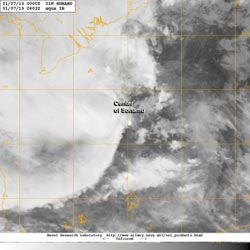Wind shear and dry air bashing Tropical Depression Sonamu

NASA's Aqua satellite passed over Sonamu on Jan. 7, 2013, and noticed that the eastern half of the storm was almost devoid of clouds and showers, which is an effect of the dry air intrusion. The bulk of the cloud cover was west of the center.<br><br>Credit: NASA/NRL<br>
On Sunday, Jan. 6, Tropical Storm Sonamu's maximum sustained winds were near 40 knots (46 mph/74 kph). Sonamu's center was located about 255 nautical miles (258.9 miles/416.7 km) southeast of Ho Chi Minh City, Vietnam, near 7.2 north and 108.9 east and continued to move west. At that time, the ragged low level center became exposed to outer winds. Satellite data showed that the strongest convection and heaviest rainfall was now pushed to the north because of wind shear.
On Monday, Jan. 7, Sonamu was curving to the southwest and is now expected to miss the Malay Peninsula. The Malay Peninsula contains the southernmost tip of Myanmar, Peninsular Malaysia, Singapore, and Southern Thailand. Sonamu is now expected to continue slowly on a southerly track.
Sonamu's maximum sustained winds are down to 30 knots (34.5 mph/55.5. kph). At 1500 UTC (10 a.m. EST/U.S.), Sonamu was located near 6.1 north latitude and 108.3 east longitude, about 290 nautical miles (333.7 miles/537.1 km) south-southeast of Ho Chi Minh City, Vietnam. Sonamu is crawling to the southwest at 1 knot (1 mph/1.8 kph). Sonamu is battling moderate wind shear, which is weakening the storm.
NASA's Aqua satellite passed over Sonamu on Jan. 7 and noticed that the eastern half of the storm was almost devoid of clouds and showers, which is an effect of the dry air intrusion. The Moderate Resolution Imaging Spectroradiometer captured an infrared image of the storm that showed the bulk of the cloud cover was west of the center.
According to the Joint Typhoon Warning Center on Jan. 7, infrared imagery shows a rapidly deteriorating, partially exposed low level circulation center with flaring convection along the western edge of the storm. Water vapor imagery indicated a pocket of dry air is wrapping along the eastern half of the low-level center toward Sonamu's center. Dry air saps convection, which forms the thunderstorms that make up a tropical cyclone.
Forecasters at the Joint Typhoon Warning Center expect that the combination of wind shear and dry air will lead to the dissipation of Sonamu over the next couple of days in the South China Sea.
Media Contact
More Information:
http://www.nasa.govAll latest news from the category: Earth Sciences
Earth Sciences (also referred to as Geosciences), which deals with basic issues surrounding our planet, plays a vital role in the area of energy and raw materials supply.
Earth Sciences comprises subjects such as geology, geography, geological informatics, paleontology, mineralogy, petrography, crystallography, geophysics, geodesy, glaciology, cartography, photogrammetry, meteorology and seismology, early-warning systems, earthquake research and polar research.
Newest articles

Trotting robots reveal emergence of animal gait transitions
A four-legged robot trained with machine learning by EPFL researchers has learned to avoid falls by spontaneously switching between walking, trotting, and pronking – a milestone for roboticists as well…

Innovation promises to prevent power pole-top fires
Engineers in Australia have found a new way to make power-pole insulators resistant to fire and electrical sparking, promising to prevent dangerous pole-top fires and reduce blackouts. Pole-top fires pose…

Possible alternative to antibiotics produced by bacteria
Antibacterial substance from staphylococci discovered with new mechanism of action against natural competitors. Many bacteria produce substances to gain an advantage over competitors in their highly competitive natural environment. Researchers…





















